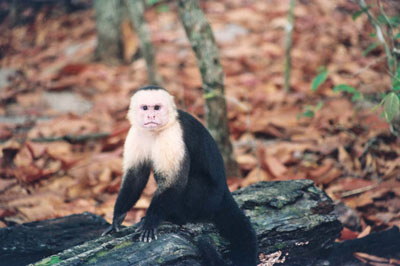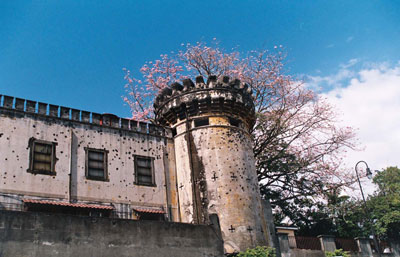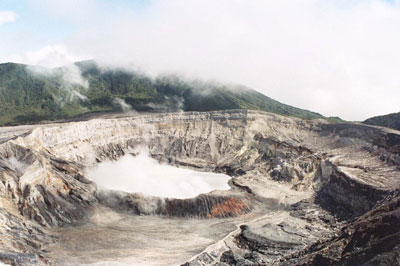Trading winter woes for Costa Rica’s sunny skies
by Jeanette Dewey, Abington, PA
As much as I enjoy the change of seasons that comes with living in Pennsylvania, by late February each year I yearn for some sunny skies and warmth. Last year I decided that a 10-day tour of Costa Rica would to be an easy solution — no hotel reservations to make or itinerary to plan and no language problems. (As it turned out, English was spoken everywhere we went and US currency was accepted.) All I would have to do is be where I was told to be at the appointed time.
I chose Caravan Tours (Chicago, IL; 800/227-2826, www.caravan.com) because of the low cost of their tour ($995 plus a $200 single supplement and $189 in taxes and fees) and the variety of available tour dates, from January through April. Not included in the cost was airfare to Costa Rica.
The scheduled 10 days seemed to provide an excellent overview of what Costa Rica has to offer. A week at any of the locations on the itinerary would be easy to arrange on your own but probably would be more expensive than booking the tour package.
So on March 29, 2008, I arrived at the San José airport, where it was warm, sunny and humid.
San José
Our group of 10 travelers was taken by van to the Barceló San José Palacio (www.barcelosanjose palacio.com), a resort-hotel that was to be our home for the first two nights and the final night of our trip. This all-inclusive resort is located about 15 minutes from the airport and has an outdoor pool, beauty and gift shops, two restaurants, a casino and many other amenities.
After dinner, the only meal not included in the tour price, I was ready to formally meet my fellow travelers at the orientation.
The following morning we went by bus to Poás Volcano National Park, about an hour’s drive from the hotel. From the paved walkway that leads up to the volcano, you can take the Botos Trail, a mile-long, downhill path that goes past Lake Botos to the parking lot. There is also a third trail, the Escalonia cloud forest trail, which is an excellent route for bird-watchers.
Back in the city, we visited the National Museum, a former Army barracks that was active during the civil war of 1948. Hundreds of bullet holes are still visible in the outside walls.
The museum contains a very impressive display on Costa Rica’s history from pre-Columbian times to the present. Be sure to see the gold and jade exhibits.
Crossing the courtyard to the butterfly garden provides a fantastic view of the city.
Tortuguero National Park
Most of the next day was spent on a long — and, at times, very bumpy — ride to Tortuguero National Park. The trip was broken up with a stop at Braulio Carrillo National Park, where we enjoyed a ride on the aerial tram and a walk through the park with a local naturalist. At our lunch stop there was a small butterfly garden.
As there are no roads into Tortuguero Park, the only way to enter is by boat. We took a pleasant ride up the rivers and canals to our accommodations at Laguna Lodge (www.lagunatortuguero.com), located between the ocean and the canal.
This rainforest eco-tourism lodge consists of rows of cabins sans phone, TV and air-conditioning. There was a pool, the only option for swimming since there is no swimming allowed in the ocean or canals. (We were told they have sharks and caimans.)
If you are an independent traveler wanting to visit the lodge, I would suggest doing so as part of a tour from San José, due to the difficulty in getting to the park and booking accommodations.
For the next two days we were taken by naturalists on boats through the park, where we saw monkeys, sloths and numerous species of birds. We also visited the home of the Caribbean Conservation Corporation, the organization which studies and protects the giant sea turtles that lay their eggs each June to October on Tortuguero’s beaches.
All too soon it was time to move on.
Fortuna
After our boat and bus rides, we had an opportunity to stretch our legs by walking across the suspension bridge in the Selva Verde Rainforest. Then it was on to our charming chalets in La Fortuna.
Las Cabiñitas consists of individual chalet-style cottages each equipped with a phone, air-conditioning and a coffee maker. There is a pool and a restaurant on the premises, and it was a safe, easy walk into town.
The only drawback was the nighttime sound of what I though were barking dogs; in reality, it was the sound of howler monkeys.
The following morning we took a cruise on the Rio Frio, which runs through the Caño Negro Wildlife Refuge. There were the requisite caimans and howler monkeys and a plethora of birds.
What made the cruise extra special was the guide’s ability to attract Blondie, a very rare, yellow-colored howler monkey.
Farther along on the cruise, we crossed the Costa Rica-Nicaragua border and were even given the opportunity to step out of the boat onto Nicaraguan soil to add another country to our list.
In contrast to a morning filled with nature, the afternoon was devoted to commercialism. The Baldi Hot Springs is really a water park with numerous concrete-lined pools containing water of various temperatures. It was relaxing moving from pool to pool, drink in hand, but it was hardly what I envision when I hear the words “hot springs.”
Nearby is the Arenal Volcano, but the glowing lava flow is visible only about 30% of the time due to cloud cover.
Jacó
The following day was spent traveling to Jacó on the Pacific coast. En route we stopped at the Children’s’ Eternal Rainforest. The land for this preserve was purchased with donations from schoolchildren around the world.
Once again it was a good opportunity to stretch our legs by going for a walk with a local naturalist, but by this time we had seen so much rainforest that it did not seem like it contained anything special.
In Jacó we stayed at Hotel Amapola (www.hotelamapola.com), a resort-type hotel. It is an excellent place to stay if visiting Manuel Antonio National Park, where we spent the following day.
The beach at Manuel Antonio is rated among the top beaches in the world, but the park has so much more to offer. Easy walking trails allow visitors to watch sloths, squirrel monkeys and a vast assortment of birds.
The park restricts the number of visitors allowed at any one time, so if you arrive late on a weekend or holiday you will need to wait in line until the requisite number of visitors leave to allow your party in. But, once in, you will not want to leave.
A final day
It was a busy trip back to San José. We stopped in Sarchi to view the painted ox carts for which the town is famous.
Next we stopped in Grecia to see the Catedral de la Mercedes. The entire church is made from metal pieces imported from Belgium in the 1890s. I’ve never seen anything like it.
Finally, we stopped on the outskirts of San José at a coffee plantation, where we viewed a live performance illustrating the history of coffee.
When we arrived back at the Barceló Palacio in San José, it felt like I had come home. If only I had. Instead, the flight home to a cold climate and gray landscape awaited.




